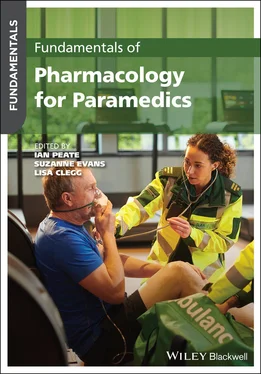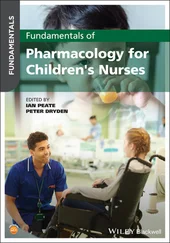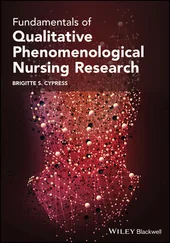Muscle tremors may also occur in these patients, due to binding of the drug to beta‐2 receptors in skeletal muscle. Although the drug is quite selective for beta‐2 receptors, it will also bind to beta‐1 receptors at high doses, so if the patient has used their puffer very extensively prior to your treatment, there may be additional tachycardia due to an action on beta‐1 receptors in the heart, increasing cardiac risk.
The drug–body interaction is a dynamic process
The interaction between any administered drug and the person it is administered to is dynamic. From the moment it is administered, the drug will be moving from its administration point to other compartments of the body, being absorbed into the bloodstream, and leaving the blood to enter other tissues or other body compartments, so the concentration of the drug in the blood and in various tissues and body compartments will be changing. As the drug passes through the liver, it will be acted on by metabolic enzymes which will convert it to a different form, which may be more or less pharmacologically active, but certainly more water soluble. The drug travelling in the blood will also be filtered by the kidneys, and the water‐soluble form of the drug will be trapped there and excreted in the urine.
As the drug is being carried around the body, some of it will arrive at and bind to its sites of action, producing its effects. Even the binding of the drug to its receptors is a dynamic process, akin to molecules playing musical chairs with the receptors – molecules of the drug will bind and detach and bind again rather than simply binding and remaining in place. Each time the molecule detaches from its binding site, it may be whipped away and metabolised, and its place on the receptors may be taken by another, competing molecule. This constantly changing relationship between the drug and the living system it has been introduced into explains a great deal about how drugs have their effects. The delay between administration and action of a drug, the duration of action of the drug, and the ability to reverse or overcome the actions of one drug by giving another drug are all the result of this dynamic interaction between drug and living system.
For the paramedic administering drugs into a system which may be free of other drugs but more likely already contains some pharmacological agents, this constantly changing effect of the drug on the patient will require you to have a good enough grasp on what these agents can do, either alone or in combination, to be able to predict and maintain some control over their actions.
One challenge we are always faced with is getting enough of a drug from its site of administration to its site of action for it to have a therapeutic effect. The drug is effectively in a race to reach its site of action and have its effect before it is chemically degraded and removed from the body. A drug which has a highly desirable therapeutic action may turn out to be useless from a clinical point of view if it cannot be delivered to its site of action. So, a drug that is going to stand a chance of being useful would usually possess characteristics which allow it to be easily absorbed into the bloodstream, preferably after oral administration, which in turn would mean that the drug would not be destroyed by the acid of the stomach or digestive enzymes. And although it would probably be subject to metabolism by the liver, the metabolism should not be so rapid that it is almost completely gone after a single pass through the liver (a phenomenon known as first‐pass metabolism), as this would mean that very little of the active drug remained in the bloodstream to circulate after absorption. Other routes of administration might avoid the problem of first‐pass metabolism, but each administration route will have its own advantages and disadvantages.
Administration of medications in the out‐of‐hospital setting can be challenging due to poor lighting, uncontrolled environment or a chaotic scene. Practising all steps of safe medication administration is key to reducing the risk of error ( Chapter 4discusses medicines management and the role of the paramedic). Ensuring the same routine is exercised every single time you administer any medications will embed safe practice so you do not overlook a crucial step during a high‐acuity incident.
Hand hygiene is important to prevent introduction of harmful pathogens in the out‐of‐hospital environment. Access to running water may not be practical in the out‐of‐hospital setting, so utilisation of alcohol‐based hand rub is the gold standard in this setting. Healthcare‐associated infections generate significant comorbidity and burden for the patient, the community and the healthcare system. Healthcare‐associated infections are avoidable and simple hygienic practice and aseptic technique are crucial in breaking the chain of transmission from community, to patient and into care settings such as hospitals.
Intravenous cannulation is a key source for bloodstream infections and risk mitigation efforts, such as use of alcohol‐based hand rub and not touching the area between cleaning the skin and immediately prior to cannulation, should be exercised.
Other routes of administration which are common in the out‐of‐hospital setting include
intravenous, intramuscular, topical, intranasal, endotracheal and intraosseous. See Chapter 6for further discussion.
Once absorbed into the bloodstream, a drug needs to be able to penetrate to its sites of action relatively quickly. If the drug was an antimicrobial being used to treat an infection of the blood, then getting enough drug into the bloodstream for long enough would be all that was required. However, if the drug were required to penetrate the central nervous system, for example, or get into joint spaces or some other protected body compartment, then it would also have to be able to move out of the bloodstream and travel through the cellular walls that form those body compartments. This presents another challenge to a molecule; in order to get through cell membranes, a drug molecule either needs to be soluble in lipids (lipophilic) or, if it is more water soluble (hydrophilic), then it would have to be a very small molecule. Drugs that are highly lipid soluble are generally able to move readily through cellular compartments without difficulty, and will therefore leave the bloodstream and enter the tissues, often concentrating there. Drugs that readily cross the blood–brain barrier, such as those used in general anaesthesia, are highly lipid soluble, allowing them to pass very rapidly into the protected environment of the brain, which explains their ability to produce general anaesthesia in a matter of seconds after being introduced into a vein.
The dose, route and timing of administration will all play key roles in the effectiveness of the drug. This is discussed in greater detail in Chapter 5.
You are treating 94‐year‐old Nelida, who has fallen in her residential aged care facility while going to the bathroom. She has a large bruise on the side of her head (temporal region) and a shortened and rotated left leg, as well as a deep laceration to her left upper thigh caused by the shard of a mirror that broke during the fall. Staff report that the patient has dementia but can still converse appropriately most days. The patient is in extreme pain but her heart rate is not elevated. You realise this is probably due to her being on a beta‐blocker for hypertension. You administer intranasal fentanyl repeatedly en route to hospital to treat her pain. On arrival, her level of consciousness has decreased. Reflecting on what might have caused this, you consider that the combination of blood loss and a blunted compensatory response due to the beta‐blockers, along with a reduced renal capacity due to her age, and the fact that the repeated fentanyl doses have not been cleared as rapidly as expected has resulted in an accumulation of medication, leading to adverse effects.
Читать дальше












